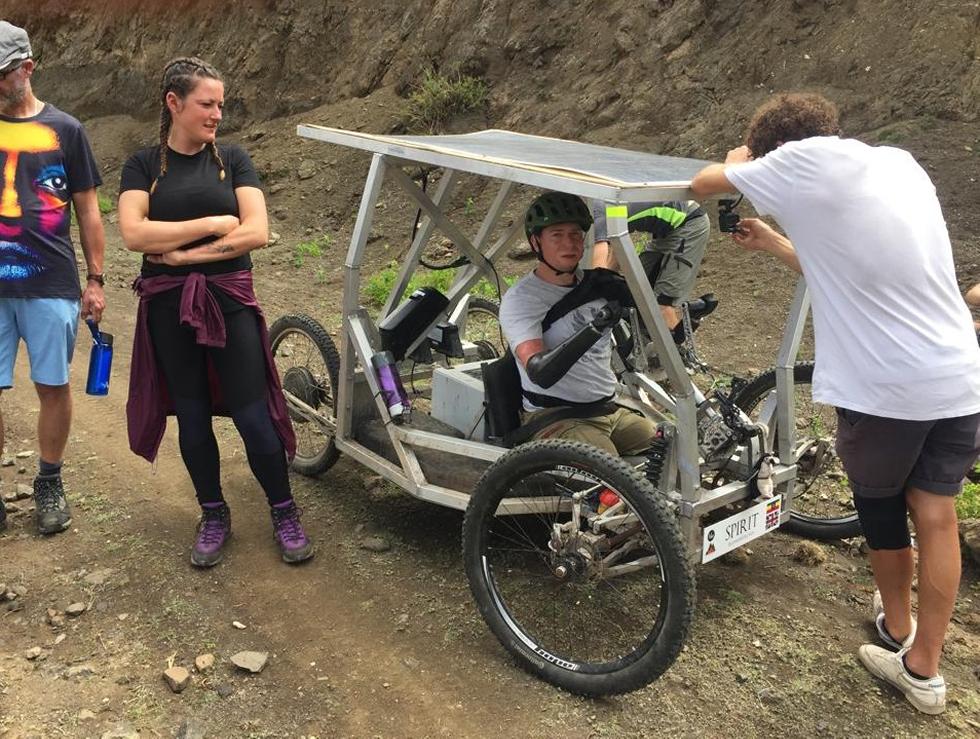Wheelchair users scale Ethiopian mountain on student-designed handcycle

In an extraordinary tale of perseverance and ingenuity, a unique handcycle designed and built by graduates of the University of Southampton has reached the summit of Ethiopia’s tallest mountain.
The Wild Wheelchairs Project expedition endured an epic journey over rough terrain and through torrential rain with quadruple amputee Alex Lewis and Ethiopian wheelchair user, Emebet Allie Deress, successfully scaling the 4,550 metres of Ras Dashen in the northern Armara region of the country. Amongst those from the University supporting the expedition were Dr David Marshall, Aerospace Engineering graduate and manager of the University’s wind tunnels, and Tom Parker, Mechanical Engineering graduate and a member of the original design team from Southampton. Both travelled to Ethiopia for the entire journey, making adaptions en route to improve the performance of the handcycles as they made their ascent.
Southampton’s Dr Clint Styles and a number of the School of Engineering technical support staff, helped to test the cycle with Alex in the UK before the expedition set off for Ethiopia.
The Wild Wheelchairs Project hopes to raise money to finance the construction of wheelchair manufacturing facilities in Ethiopia, which will transform the lives of hundreds of disabled people living in the eastern African nation.
During an arduous journey over several days, Alex and Emebet successfully powered their way through driving rain and mud over roads that were, at times, severely eroded. This was a particular challenge for the pair. Alex had both of his arms and both of his legs amputated, as well as undergoing extensive skin grafts and facial reconstruction, after contracting strep A toxic shock syndrome, septicaemia and necrotising fasciitis in 2013. Emebet, now 19, was hit by a car at the age of three and lost both her legs from the knee down. She now plays wheelchair basketball, races tricycles and is also keen to take on the challenge.
At one stage, the pair managed to drive their handcycles past a bus stuck in the mud. A few days later, the support team had to carry the handcycles across a river ford in knee-high water.
The team’s Land Rover also had to intervene as the handcycles encountered steep gradients, towing it up and over hills at times, including the pass at Bwahit Peak, at an elevation of 4,200m.
The expedition has also featured many poignant moments. On market day in the village of Cheru Leba, the team attracted a great deal of attention with Alex shaking many people’s hands and on the way out of town before being met by a local man using a wheelchair who came out into the street. During a later visit to a small settlement that had sprung up by a road construction camp, scores of children followed the expedition for several kilometres as it set off along the eastern side of a widening gorge.
The full journey is being filmed by director Simon Ratigan for a documentary to be screened later.
Ambitious student project
The designers of the handcycle - Christopher Charalambous, Gayan Kahatota Lyanage, Guillaume Henry, Junaid Mahomed, Jin The and Tom Parker - embarked on the challenging task for their fourth year Group Design Project, the culmination of their Mechanical Engineering (MEng) studies at the University of Southampton. The group advanced the project with supervisors Professor Andrew Cruden and Dr Lindsay-Marie Armstrong. The project was honoured in the Engineering Impact Awards' Student Design Showcase at the National Instruments Week 2019 conference in Austin, Texas.
Their original design was unveiled during the University’s annual Design Show in June 2018 with extensive testing continuing over subsequent months. Christopher Charambolous secured a summer internship in 2018 to continue working on the project once the original University assignment was concluded.
“Alex’s team told us about the difficult conditions in Ethiopia, it’s a very mountainous area and the roads are bad,” said Christopher prior to the recent expedition. “We are using solar power to help him tackle the climb and all the materials have to be light yet robust enough to cope with the terrain.
“Safety is all-important too,” Christopher explained. “Alex has to clip himself into the handcycle to make sure he’s safe while he’s using it and that was a difficult mechanism to design and test.”
“Limited mobility is something that affects millions of people globally,” he concluded. “To be able to work with individuals who want to make a positive difference through emerging technologies, in this case a seriously cool hand cycle, is a privilege as it has an end-user in mind. Through briefing, design, testing and the subsequent attempt to cycle up Ras Dashen we will be able to highlight the University but also show that anything is possible when you put a collective of enthusiastic minds to it.”
Click here to visit the Wild Wheelchairs Project website.



